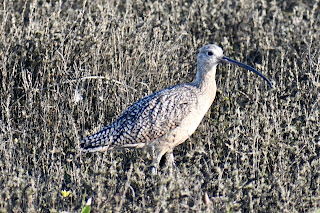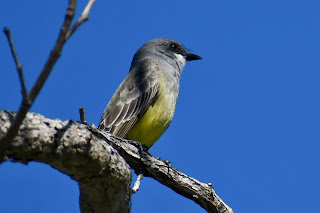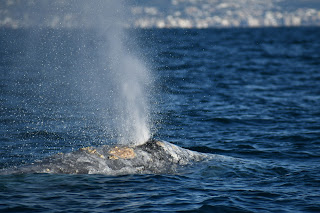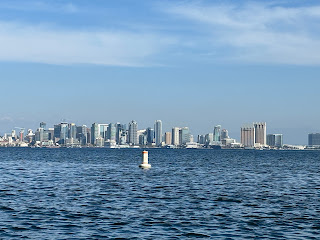San Diego Whale Watching - 2/13/2024
On Tuesday my daughter booked us on an afternoon whale watching tour. I was hoping to use this as an opportunity to see some pelagic birds along with the whales. We would have to get further from shore than normal since the winds had been offshore since our arrival. The tour company mentioned on its website that they go out as far as 12 miles. But the primary targets are whales and dolphins, so they will likely only go as far as it takes to spot the cetaceans. Gray whales are the only species in the area this time of year which I didn’t mind since we don’t get them on the east coast. I really want to see a blue whale, but it is too early in the year for them. When my daughter read the tour company’s information from the website it mentioned that they take you out on military grade inflatable boats. My wife and I were not to keen on that idea. Mostly because we didn’t pack in anticipation of getting drenched by waves and sea spray. My daughter booked it anyway.
In the morning I walked around the Paradise Marsh area again, exploring a little more of the area than the day before. I walked around for a little more than an hour-and-a-half and logged 20 birds species. My highlights were: American wigeons, pintails, redheads, pied-billed grebe, American coot, short-billed dowitchers, over 30 marbled godwits, about 300 willets, a long-billed curlew, at least four Anna’s hummingbirds, black phoebes and two California towhees.
Top, long-billed curlew. Above, marbled godwits. © S. Weiss
Afterwards, on our way to downtown San Diego before our whale tour, we stopped at a small park where a green-tailed towhee had been frequenting. This species has eluded me on several attempts on both the west and east coasts. It got the best of me yet again. Sunnyslope Park was a very small park, so my wife and daughter waited in the car while I made a few laps around the park perimeter. I saw about a dozen or so birds in 25 minutes and the only towhee I saw or heard was another California towhee. I did find another summer tanager which eBird flagged as rare, just as it did in Los Angeles County.
Left, summer tanager. Right, Cassin's kingbird. © S. Weiss
When we arrived at San Diego Harbor, I noticed that the wind was not bad. My wife and I were now embracing the idea that this was going to be a fun adventure. We were not disappointed. There were only three other patrons besides us taking the day's last tour. We donned our life jackets and climbed into the low-profile rigid inflatable boat. On the way out of the marina I spotted an eared grebe. That would be the best bird of the trip. The only others were basically pelicans, gulls, cormorants and an occasional royal tern. That was okay though, because the cetacean show was better than we had hoped. Before we made it out to the ocean, we spotted a young gray whale inside the harbor. It was feeding on whatever baitfish were around. We didn't spend much time on it as our guide said this would be our go-to whale on the way back if we failed to see any out on the ocean.
Not too long after we got out of the harbor, we came across a few seals chasing food like dolphins, breaking the water's surface as they swam. We stayed with them for just a bit because our guide and captain had radio communications with another whale watching boat of a pair of whales only a few miles away. We came near the much larger whale watching vessel, and soon after we spotted our first gray whale. There were two of them. We stayed with them for a while, watching them surface and dive. At one point we crossed into Mexican waters because I received a text message from Verizon welcoming me to Mexico. There were times I could see the whale rising up from the depths below before the others saw its blow spot at the surface. They were close enough to hear them expel the air from their spouts. In all, we saw at least three whales out on the ocean.
The whales were on a mission to continue their southbound migration. So, after a while we reluctantly had to move off from the whales. Almost immediately we were in a massive pod of dolphins, probably over a hundred scattered around us in all directions. They were mostly common dolphins with some Pacific white-sided dolphins too. Here is where this particular tour company's sale pitch came into play. Their low-profile boats put us right in with the dolphins, almost at eye level, as they zipped by us and under us. The boat's other advantage was its speed. The faster we went, the more the dolphins wanted to follow and interact with us. It was a completely different experience than any other other pelagic tours I’ve been on, and well worth it. Plus, other than a little spray in my face, we didn't get wet.
Gray whale raising its fluke as it deep dives. © S. Weiss
Gray whale blow spot and blow holes. © S. Weiss
On the way back into the harbor we came across Junior again. That was the name our guide tagged the young whale we saw on our way out. He also took us past some floating bait boxes anchored in the harbor that are used to supply the fishing boats on their way out in the mornings. The boxes now were floating rest stops for seals and sea lions. There were also pelicans, egrets, herons and cormorants using the holding boxes to pick out some fresh anchovies through the openings.
Common dolphins. © S. Weiss
California sea lions. © S. Weiss
Left, USS Sampson. Right, USS Michael Monsoor. © S. Weiss
The Sampson is an Arleigh Burke-class guided missile destroyer. The Monsoor is a Zumwalt-class guided missile destroyer. Naval Base San Diego is home to the U. S. largest Pacific surface fleet.























Comments
Post a Comment